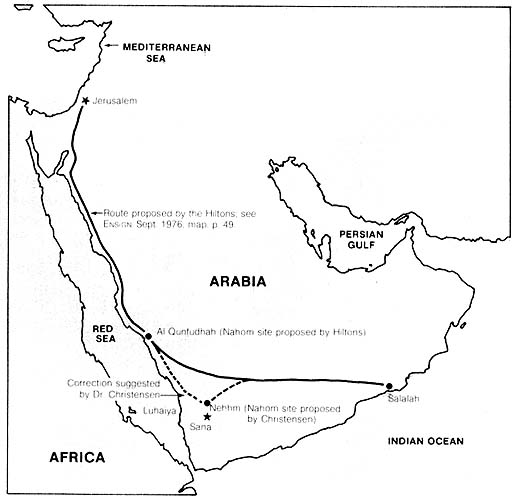“Comment,” Ensign, Aug. 1978, 73
Comment
Thanks for Conference Issues
Although I’ve always felt a need for conference, the need never seemed greater than it was this last time [April general conference]. And what was given never seemed so helpful … so personal … so exacting … so uplifting. And while I took notes, there were gems I missed, so I’m looking forward to reading the Ensign and devouring them and spending six glorious months living and sharing them with others. So please keep up your good work with the publication of the conference issues.
Cheryl Karres
Salt Lake City, Utah
The Place Called Nahom
Lynn and Hope Hilton opened exciting possibilities with their travel along the presumed route of Lehi’s trail. (See Ensign, Sept./Oct. 1976.)
The Book of Mormon states that Lehi and his party traveled along the shore of the Red Sea for some distance, and then turned due east. (See 1 Ne. 16:13–14, 1 Ne. 17:1.) The Hiltons have supposed that the eastward journey ended at Salalah, an oasis settlement on the shore of the Indian Ocean—speculated to be the place the Book of Mormon calls “Bountiful.”
Particular interest therefore attaches to the point at which the colony changed its route from “nearly a south-southeast direction” parallel to the Red Sea (1 Ne. 16:13) to “nearly eastward from that time forth” (1 Ne. 17:1) until they reached Bountiful.
That turning point was probably the place where Ishmael, father of the family that intermarried with that of Lehi, was buried. “Ishmael died, and was buried in the place which was called Nahom.” (1 Ne. 16:34.)
That wording—“was called”—suggests that it was a well-known spot, at least locally. The verb is used differently in verse 13, which tells of an earlier stop the group had made: “We did call the name of the place Shazer.” (Italics added.)
It is unlikely that modern scholars will ever locate with confidence the rest stop to which travelers of a lonely caravan gave the name Shazer—simply because they may never have spoken that name to anyone outside their group.
But Nahom is different. The name in Hebrew seems to mean “mourning,” or perhaps “comfort” or “consolation.” Was it a burial ground—a cemetery—to which the local people led the mourning travelers when one of their leaders died? (See Hugh Nibley, Lehi in the Desert, pp. 90–91.) Perhaps it was similar to the cemetery which Gerald W. Silver, who accompanied the Hiltons, photographed near Al Qunfudhah. (See Ensign, October 1976, p. 54.)
Although Nephi in his account makes no explicit mention of any person outside his father’s group as it passed through Arabia, the land must surely have been peopled. In view of the well-known longevity of place-names in the Semitic world, we could perhaps hope to find a name such as Nahom preserved in the speech of recent inhabitants. Its form would be altered, of course; at least minor changes in pronunciation would be expected with the passage of so many centuries.
Little mapping has been done in Arabia, however; detailed maps exist for only small parts of the land. Nevertheless, “the place called Nahom” may already have been found!
In 1763 Carsten Niebuhr prepared a map of Yemen (South Arabia or “Arabia Felix”) as a major project of the scientific expedition sent out by King Frederick V of Denmark. The name “Nehhm” appears on that map. It was a small administrative district located among the mountain valleys some 100 miles east of Luhaiya and about 25 miles north of the capital, Sana. (See accompanying map; also Thorkild Hansen, Arabia Felix: the Danish Expedition of 1761–1767 (1964), pp. 232–33.)
And what bearing does this have upon the route traced by Lynn and Hope Hilton? If the “Nehhm” of Niebuhr is accepted as the equivalent of “Nahom” of the Book of Mormon, then the discovery might confirm the general itinerary traced in the Hiltons’ article. (See Ensign, Sept. 1976, ill. 7, p. 49.) Nehhm is only a little south of the route drawn by the Hiltons. Nehhm could thus be the place where Ishmael was laid to rest, where his daughters “did mourn exceedingly” (1 Ne. 16:35), and whence the caravan then turned eastward toward the Indian Ocean.
Perhaps the next step would be to invite semiticists to give their opinions as to whether Nahom and Nehhm are probable phonetic equivalents.
Another step would be to search for the name on maps other than Niebuhr’s, even going back to medieval and ancient ones, if any can be found.
Still another step—when the political situation allows—would be archaeological fieldwork. Each of these steps should help to define more precisely the setting in which the Book of Mormon story unfolded itself.
Ross T. Christensen
Professor of Archaeology and Anthropology
Brigham Young University

Nehhm, located a little north of Sana, capital of modern Yemen (in southern Arabia), may be the Book of Mormon location, Nahom. If it is, then Lynn and Hope Hilton’s 1976 tracing of Lehi’s route across Arabia is confirmed—with a minor correction.